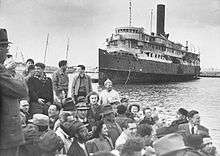Second Aliyah
| Part of a series on |
| Aliyah |
|---|
 |
| Jewish immigration to the Land of Israel |
| Concepts |
| Pre-Modern Aliyah |
| Aliyah in modern times |
| Absorption |
| Organizations |
| Related topics |
The Second Aliyah was an important and highly influential aliyah (Jewish emigration to the Land of Israel) that took place between 1904 and 1914, during which approximately 35,000 Jews immigrated into Ottoman-ruled Land of Israel, mostly from the Russian Empire,[1] some from Yemen.
The Second Aliyah was a small part of the greater emigration of Jews from Eastern Europe which lasted from the 1870s until the 1920s. During this time, over two million Jews emigrated from Eastern Europe. The majority of these emigrants ended up in the United States where there was the greatest economic opportunity. Others ended up in South America, Australia, and South Africa and only a small fraction of Jews who migrated went to Palestine.[2]
There are multiple reasons for this mass emigration from Eastern Europe and the most commonly talked about is the growing antisemitism in Russia and the Pale of Settlement. The manifestations of this antisemitism were various pogroms, notably the Kishinev Pogrom and the pogroms that attended the 1905 Russian Revolution. The other major factor for emigration was economic hardship. The majority of the Jewish population of Eastern Europe was poor and they left in search of a better life. Jews left Eastern Europe in search of a better economic situation which the majority found in the United States.[3]
Palestine on the other hand offered very limited economic incentives for new immigrants. Palestine was not a place for poor immigrants to come and better their economic situation because there was very little industry. Thus, the majority of the Jewish immigrants found a livelihood through working the land.
Settlement
The Second Aliyah immigrants were primarily idealists, inspired by the revolutionary ideals then sweeping the Russian Empire who sought to create a communal agricultural settlement system in Palestine. They thus founded the kibbutz movement. The first kibbutz, Degania, was founded in 1909.
Those among the immigrants, such as Akiva Aryeh Weiss, who preferred to settle in cities created Ahuzat Bayit near Jaffa, which was later renamed to Tel Aviv.
Wider immigration and Zionism
There is a large misconception that Zionism played a major role in the immigration of Jews to the Land of Israel during The Second Aliyah. While Zionism may have had some influence, it cannot be viewed as a substantial factor of influencing emigration to Ottoman Syria when looking at the greater context of Jewish emigration from Eastern Europe. The two major reasons for Jewish emigration were economic and due to persecution and Ottoman Syria did not offer a respite from either. Jews emigrating from Eastern Europe often experienced much hardship on their way to their destinations, especially those going to Palestine.[4] Ottoman government had been negative to the migration of Jews ("Yishuv") to Palestine from late 19th c. till the end of the 1st World War. One of the reasons was that most of the Jews had foreign citizenship, which curtailed the Empire's ability to deal with them and enforce Ottoman law. Expulsions, deportations, arrests, denial of Ottoman nationality were some of the measures used to contain the Jewish immigration. Among the deportees were David Ben-Gurion and Yizhak Ben-Zvi.[5]
The idea that the Second Aliyah was a realization of the zionist movement does not take all the hardships endured by the immigrants into account. Because of this, the majority of Jewish emigrants went to the United States where there was much more economic opportunity. Between the years 1907-1914 almost 1.5 million Jews went through Ellis Island, while only about 20,000 immigrated to Palestine.[6] The Zionist ideology played a minor factor for Jewish emigration to the Land of Israel as indicate by the proportionally small number of immigrants compared to those who went to the US.
The word Aliyah in Hebrew means ascent, which has the idealistic connotation of returning to the ancient Jewish homeland, reflected by Zionism. In reality Zionism had little influence on Jewish immigration to the Land of Israel during that period. As the Zionist movement gained strength through the 20th century, more Jews immigrated to the Land of Israel as a result. However, during the Second Aliyah period, 1904-1914, Zionism did not play an big role in influencing Jewish immigration.
Culture
The Second Aliyah is largely credited with the Revival of the Hebrew language and establishing it as the standard language for Jews in Israel. Eliezer Ben-Yehuda contributed to the creation of the first modern Hebrew dictionary. Although he was an immigrant of the First Aliyah, his work mostly bore fruit during the second.
Ya'ackov Ben-Dov became the first film maker to work in Hebrew.
The Second Aliyah also established the first Hebrew high school in Israel, the Herzliya Hebrew High School, Tel Aviv.
Defense
The Second Aliyah created the security organization, HaShomer, which became the precedent for future Jewish defense organizations such as the Haganah.
References
- ↑ Israeli government site on the Second Aliyah
- ↑ [Gur Alroey, Galveston and Palestine: Immigration and Ideology in the Early Twentieth Century, American Jewish Archives Journal 56 (2004): 129]
- ↑ [Gur Alroey, Journey to Early-Twentieth-Century Palestine as a Jewish Immigrant Experience, Jewish Social Studies, 9 (2003) 28]
- ↑ [Gur Alroey, Journey to Early-Twentieth-Century Palestine as a Jewish Immigrant Experience, Jewish Social Studies, 9 (2003) 59-60]
- ↑ Yuval Ben-Bassat, Enciphered Ottoman telegrams from the First World War concerning the Yishuv in Palestine, Turcica, 46, 2015, p. 282- 285.
- ↑ [Gur Alroey, Galveston and Palestine: Immigration and Ideology in the Early Twentieth Century, American Jewish Archives Journal 56 (2004): 139]
Further reading
- Ben-Gurion, David, From Class to Nation: Reflections on the Vocation and Mission of the Labor Movement (Hebrew), Am Oved (1976)